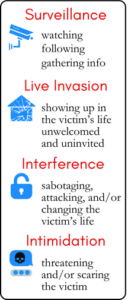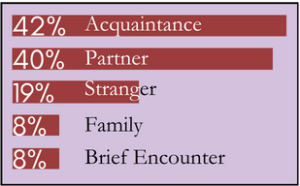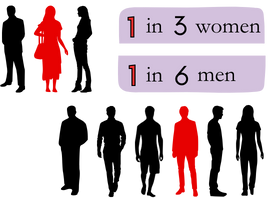
Know It. Name It. Stop It.



Fig.2: SLII Strategies
Stalking is an attributable behavior. Ringing a doorbell or sending flowers isn’t illegal or stalking, but done with the purpose, directed at a specific person, which causes a reasonable person to feel fear, is stalking.
Behaviors and actions taken by stalkers typically fall into 4 categories. Most stalking overlap and occur concurrently. These tactics are called the "SLII Strategies": surveillance, live invasion, interference, and intimidation. Examples of these tactics can be seen in Fig.2.
Victims of stalkers are unlikely to actually use the word “stalk”. They describe the behavior as “scary” or leaves them feeling “afraid” or “threatened”. Listen for these behaviors!

As stated in The National Intimate Partner and Sexual Violence survey (Smith, Basile, Kresnow 2022), nearly 1 in 3 women and 1 in 6 men (Fig.2) reported stalking victimization at some point in their life. Furthermore, 1 in 15 women and 1 in 24 men reported stalking in the past twelve months at the time of the survey.

Fig.3

Fig.2
Across the board, women are more likely to be stalked. Men are more likely to be stalkers, regardless of the gender of the victim. Another misconception is that the stalker is a stranger, following the victim from afar. Rather, between 40% to 45% of stalkers are acquaintances or current/former partners (Fig.3).
This is true for male and female victims.

It is not your fault as a victim, nor as a bystander. It is the stalker who must take accountability for their actions against another. This does not mean that the victim, nor bystander is helpless to the whims of the stalker.
The bystander effect is real, and should not be overshadowed in the discussion of how to stop stalking.
Don’t Downplay or Minimize
Documentation!
Learn more about Stalking Awareness.

Sylvia’s Blog
- Comorbid Dangers: Financial Abuse November 4, 2024
- Comorbid Dangers: Domestic Violence & Animal Abuse September 16, 2024
- Mental Health Awareness Month June 25, 2024





